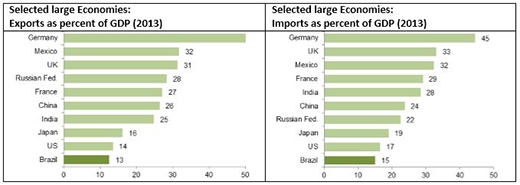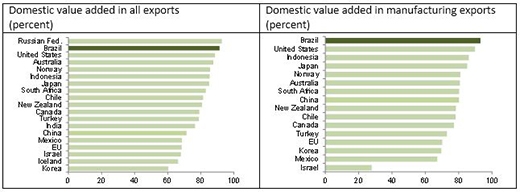Brazil’s is an unusually closed economy as measured by trade penetration, with exports plus imports equal to just 27.6 per cent of GDP in 2013.

By Otaviano Canuto, Cornelius Fleischhaker and Philip Schellekens
Brazil’s large size is often used to explain its relative lack of openness. But this argument does not stand up to scrutiny: among the six countries with larger economies than Brazil’s, the average trade-to-GDP ratio is 55 per cent. Given the size of its economy, we would expect Brazil’s trade to be equal to 85 per cent of GDP, three times its actual size.
Controlling for other dimensions of country size (surface area and population) and structural features often associated with trade openness (urbanization, manufacturing share in GDP) still cannot adequately explain Brazil’s lack of openness.

Source: World Bank WDI database
Lack of trade dynamism at the company level
Brazil’s lack of openness becomes even more apparent if we look at the number and characteristics of exporting companies. Very few Brazilian companies export. Indeed, the absolute number of exporters in Brazil – fewer than 20,000 – is roughly the same as that of Norway, a country of just over 5m people compared with Brazil’s 200m. This means that, while in Norway there is one exporting company for about every 250 Norwegians, the ratio in Brazil is one for every 10,000 Brazilians.
Of course, Norway and Brazil are vastly different countries. But looking at a larger set of countries, we observe that Brazil is indeed an outlier. Its number of exporters relative to the population is low even when controlling for GDP per capita.
A very small number of companies are responsible for the overwhelming share of Brazilian exports. The top 1 per cent of exporters generate 59 per cent of total exports, while the top 25 per cent account for 98 per cent of export revenues. Brazilian exporters also lack dynamism. Brazil has a very low entry rate, very few companies become new exporters and established exporters have a very high survival rate.
Why do so few companies export?
Brazil’s extraordinary lack of openness and its small number of exporters are closely related to the fact that Brazilian companies are poorly integrated into transnational value chains. This can be observed in the very high share of domestic value added in Brazilian exports, which implies that such exports incorporate few components and intermediate goods imported from other countries.
The high level of domestic value added is not accounted for solely by Brazil’s commodity exports, which have a very high degree of domestic value. Even in Brazil’s manufacturing exports (about a quarter of total exports) domestic value added is still extremely high, at 93 per cent. Indeed, it is the highest among all economies for which such data are available.
This high level of domestic value added shows that the global fragmentation of production processes along cross-border value chains, a very important part of thesecond wave of globalisation, has largely bypassed Brazil. The factors behind this are multiple. They include precarious logistics and high transaction costs related to international trade, as well as deliberate policy decisions to favour local content over international integration.

Source: World Bank 2014
Over the past decade, Brazilian companies have also faced serious challenges to competitiveness, such as exchange rate appreciation and defensive trade policies. The result is that only the largest and most efficient companies enjoying significant economies of scale are able to overcome barriers to export.
How could opening up support Brazil’s growth agenda?
Opening up and integrating more deeply into global value chains would result in the closure of uncompetitive production chain segments and their replacement with imports. The surviving businesses would be more competitive thanks to their access to imported inputs, allowing them to create products of lower cost and higher quality. Furthermore, in dynamic terms, integration into global value chains would allow scarce domestic resources such as skilled labour to be reallocated to the most productive companies and activities, increasing overall productivity.
As the potential productivity gains from participation in global production networks increase, so does the opportunity cost of Brazil’s failure to open its economy. The alternative to openness – vertically integrated supply chains behind protectionist barriers – is likely to be futile in the long term. Despite rising trade barriers, Mercosur’s coefficient of imports from China has continued to increase in recent years. Private investors understand this, as they shy away from activities that are viable only under permanent protection.
Given Brazil’s current labour shortages, productive activities would be strengthened by the availability of imported intermediate and capital goods. Brazil’s immersion in global value chains would allow the country to leverage its comparative advantages which clearly exists in natural resource-associated industries but which could also emerge in specific activities in manufacturing or services, once industries have access to cheaper inputs. Of course, the support of public policy remains essential. However, such support should be more horizontal in nature, rather than further encouraging the ongoing high density of production chains and perpetuating the extraordinary lack of openness in the Brazilian economy.
Otaviano Canuto is a senior advisor and former vice president at the World Bank; Cornelius Fleischhaker is a junior professional associate at the World Bank; and Philip Schellekens is a senior economist at the World Bank. All opinions expressed here are the authors’ own and do not necessarily reflect those of the World Bank. A version of this post was previously published by Vox.



As an American anthropologist living in Brasil for over seven years, my research has revealed that this article strikes at the heart of several factors constraining economic growth in Brasil. Historically, one must remember that this mentality “defensive trade policies” is not something new to Brasil. Brasilian policy makers have almost always had a fear of being exploited by foreign businesses. For example, in the early decades of the twentieth century, Brasil found itself in the midst of economic crisis and social unrest. This crisis was brought on by a failed attempt to modernize only through its export agricultural industry. By 1930, a military junta brought Getúlio Vargas into power and he attempted to modernize the country through a corporatist approach. This involved setting up a network of state enterprises aimed at bolstering domestic production. Under Vargas, trade unions were subordinate to modernization and a repressive state apparatus went into effect. However, Brasil soon discovered that it could not survive economically cut off from the rest of the world. The Import Substitution Model was a governmental economic plan that made use of trade restrictions, subsidies, and fiscal incentives that supported the development of national industries producing for internal markets, however, without need to compete for efficiency or cost. Although by the 1960s and 70s, there were many foreign companies doing business in Brazil such as GM, Fiat, Volkswagen, Ford, Chrysler, companies strong in energy, chemicals, pharmaceuticals, and information technology, these multinational companies had to coexist with state-owned corporations in oil, electricity, telecommunications, and steel production. The financial system was dominated by state-owned banks and were closed to foreign companies, and made use of high tariffs to protect Brazilian and local branches of multinational companies.
When we consider the cultural aspects at work, we must remember that Brasil is the only country in South America whose people speak the Portuguese language. This factor has two consequences; one positive and the other negative. On one hand, it acts as a culturally unifying factor among Brasilian people. On the other, it culturally isolates Brasilians from other populations in South America who share a Spanish cultural heritage. Both of these considerations have impacted Brasil’s manner of conducting business; one socio-economically and the other socio-culturally.
Sources: Schwartzman, Globalization-Poverty-Social Inequality, 2003, page 9; Maarten van Klaveren, An Overview of Women’s Work and Employment in Brazil, Amsterdam Institute for Advanced Labor Studies-AIAS, 2009, page 8.
LikeLiked by 1 person
Posted by Neil Turner | February 8, 2015, 4:53 pm